(so weit der „Freedom of Information Act“ den Blick in die Archive der jüngsten Geschichte zulässt. Die Test-Einsätze der Mini-Nukes, der Einsatz von DU-Munition scheint in den freigegebenen Akten noch nicht enthalten zu sein. Ebenfalls nicht enthalten sind m.E. die Berichte über das US-Geo-& Weather-Engeneering, die damit mögliche Auslösung von Erbeben, Seebeben, die Umlenkung der Golfströme etc … und die langfristige Auswirkung der zivilitärischen Experimente im Weltall. Ganz zu schweigen von den Auswirkungen der laufenden Kriege und Kriegs-Manöver)
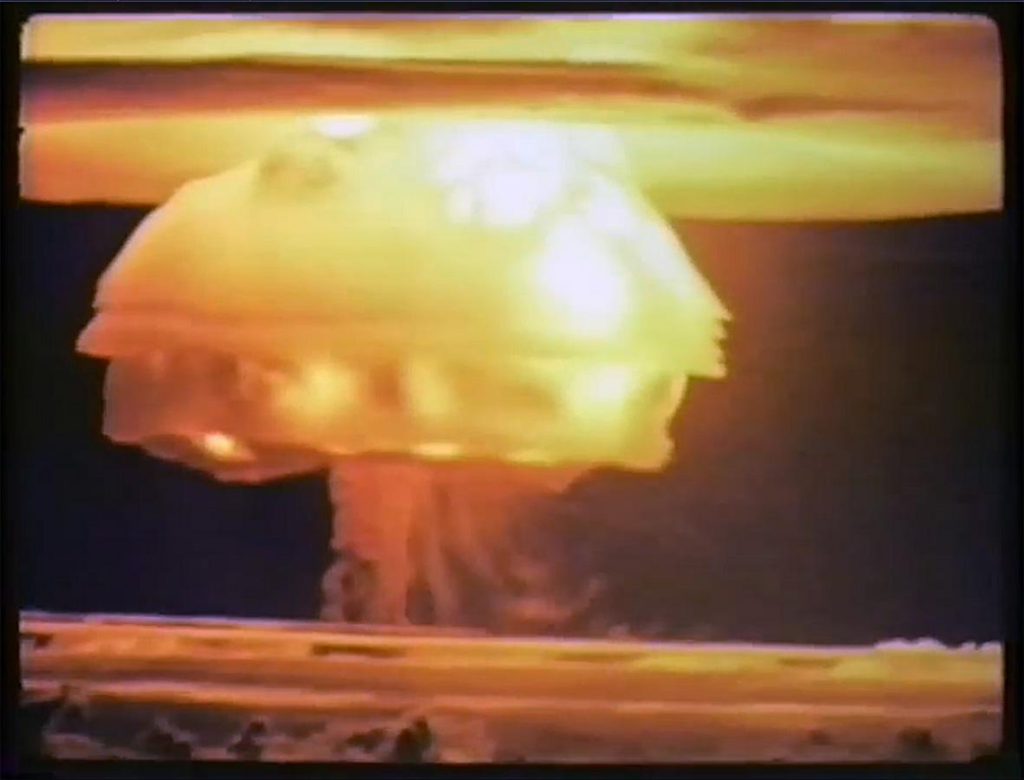
A still frame from the U.S. Air Force film, “Operation Castle Commander’s Report,” shows the moment, 40 seconds after detonation, when the fireball produced by the Bravo test reaches five miles above sea level.
Castle BRAVO at 70: The Worst Nuclear Test in U.S. History | National Security Archive (gwu.edu)

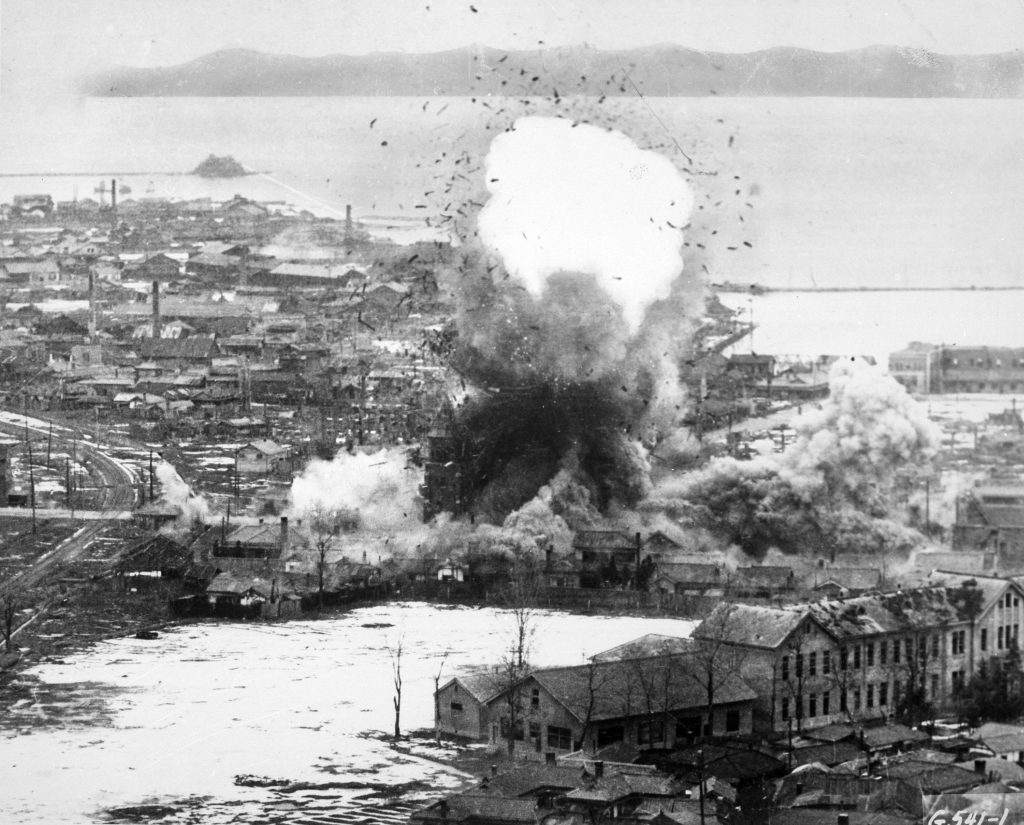
Wie viele US-Atombomben in den 50er Jahren über Korea abgeworfen wurden und wie viele Akut und Langzeit-Opfer es gab, muss ich noch recherchieren
Sind ganz kleine Bomben
und die schaden kaum,
eines schönen Mordens
erwachst Du aus dem Traum,
die Niedrig-strahlen doch nur
zehntausend Jahre lang,
entsorge Klimasorgen,
entsorge Angst und Bang,
verschieb es nicht auf Morgen …
denn der Weltunter- ist schon
angeblich längst im Gang
Glaub nicht an die Propheten
mit ihrem Büßerzwang
folg nicht dem Ruf zum Beten
sonst greifst Du gleich zum Strang
Das wird BAAL nicht dran hindern
die Erde zu versenken
Und Du kannst Deinen Kindern
die heile Welt so nicht mehr schenken
die Nachgeborenen wollen nicht dran glauben
Den Überlebenden bleibt auf Dauer nichts verborgen

Sag ich doch: Mini-Nukes und schon jetzt strahlende Gesichter. Der Nachteil ist dabei allerdings, dass der Immobilienwert der freigebombten Grundstücke am Strand von GAZA erst sehr lange nach dem DAY AFTER wieder steigen wird.
Castle BRAVO at 70: The Worst Nuclear Test in U.S. History
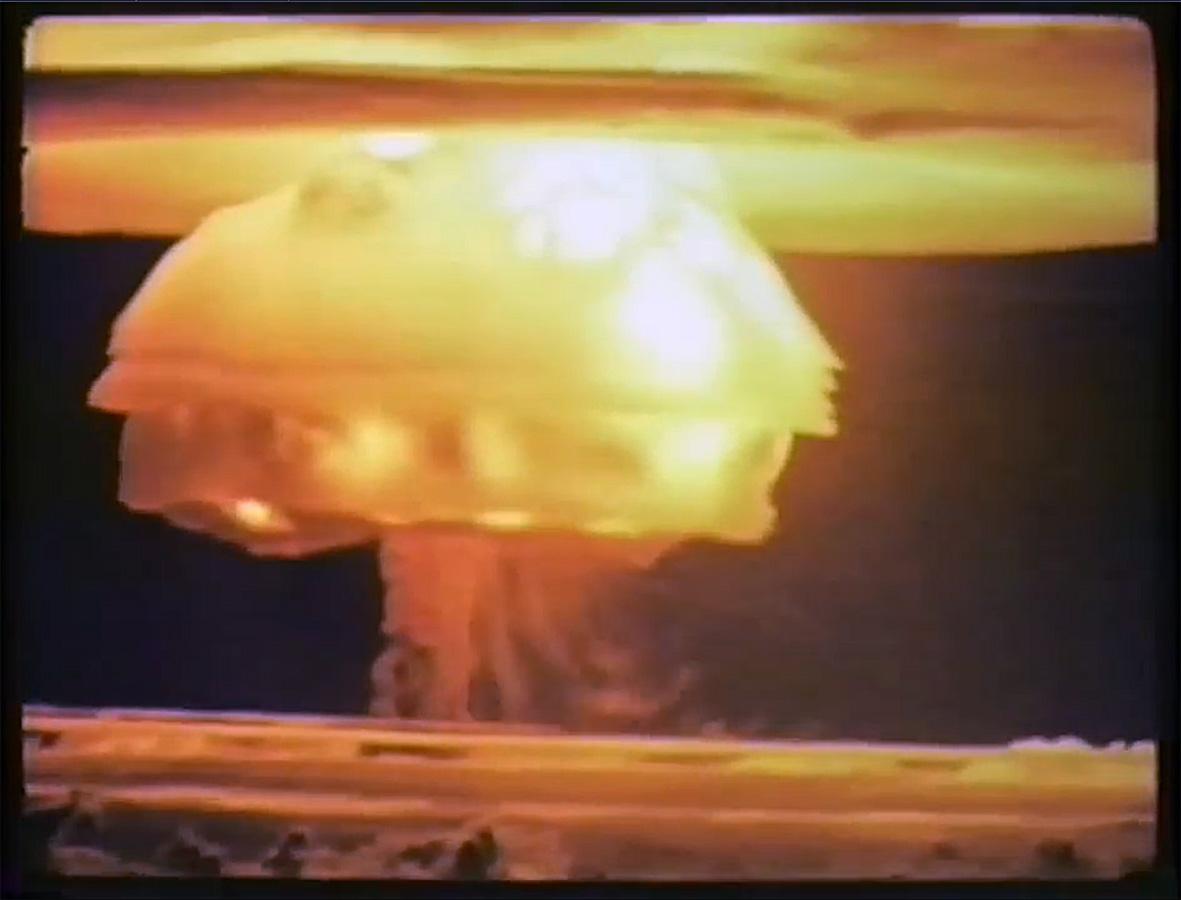
A still frame from the U.S. Air Force film, “Operation Castle Commander’s Report,” shows the moment, 40 seconds after detonation, when the fireball produced by the Bravo test reaches five miles above sea level.
Heavy Fallout from Test Sickened People on Marshall Island Atolls and Japanese Fishermen on Lucky Dragon
Blast Equivalent to 1,000 Hiroshimas Vaporized Ten Million Tons of Coral, Sand and Water
“No Place to Hide”: 1954 Model Overlaid Bravo’s Fallout on Northeastern U.S.
U.S. Weapons Designer: “We Didn’t Know What the Hell We Were Doing”
Published: Feb 29, 2024
Briefing Book #
853
Edited by William Burr
For more information, contact:
202-994-7000 or nsarchiv@gwu.edu
Subjects
Nuclear Proliferation and Accidents
Regions
Project
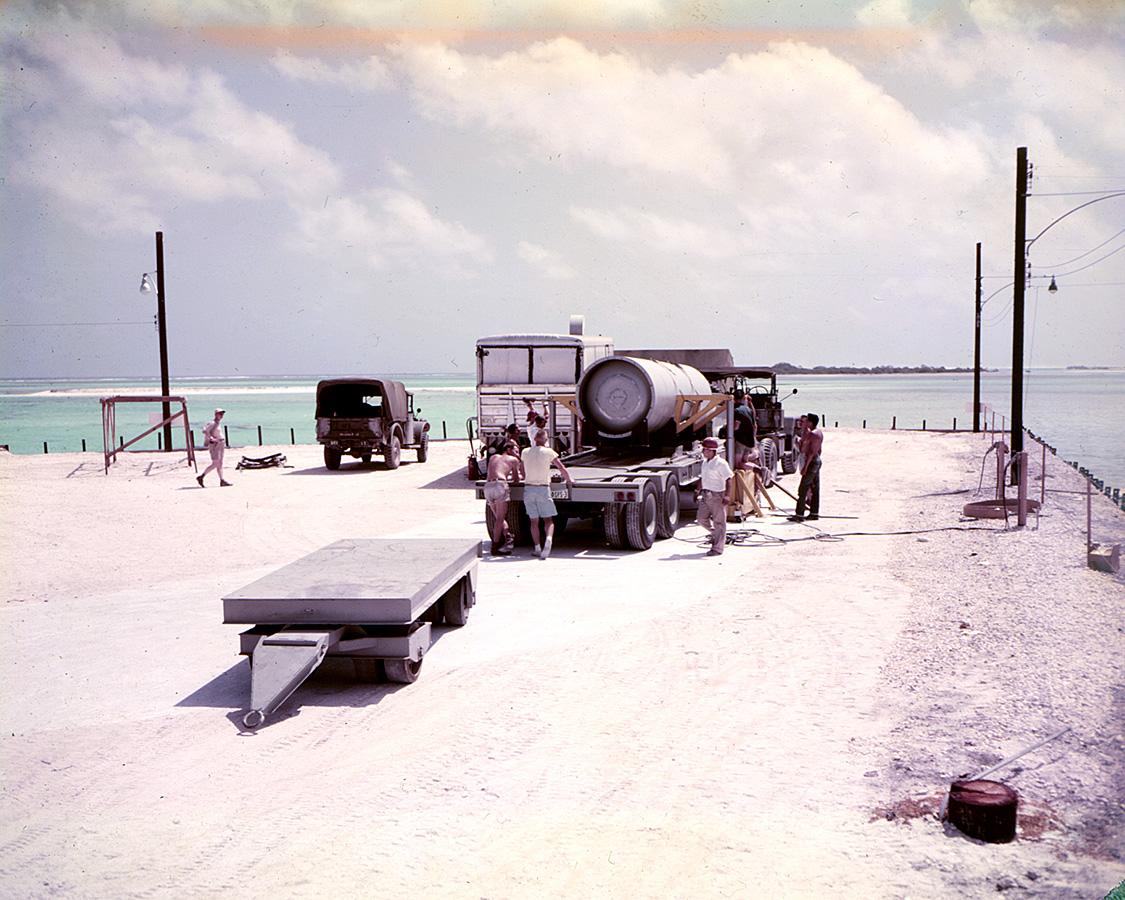
The „Shrimp“ test device is shown loaded on a flatbed truck, 20 February 1954 (Photo from Los Alamos National Laboratory collections; courtesy of Alex Wellerstein)
Black and white film of the Castle Bravo detonation taken by Los Alamos National Laboratory (Courtesy of Alex Wellerstein)
U.S. Air Force Lookout Mountain Laboratory/Joint Task Force 7 Documentary Film, „Operation Castle Commander’s Report,“ n.d., sanitized copy (excerpt)
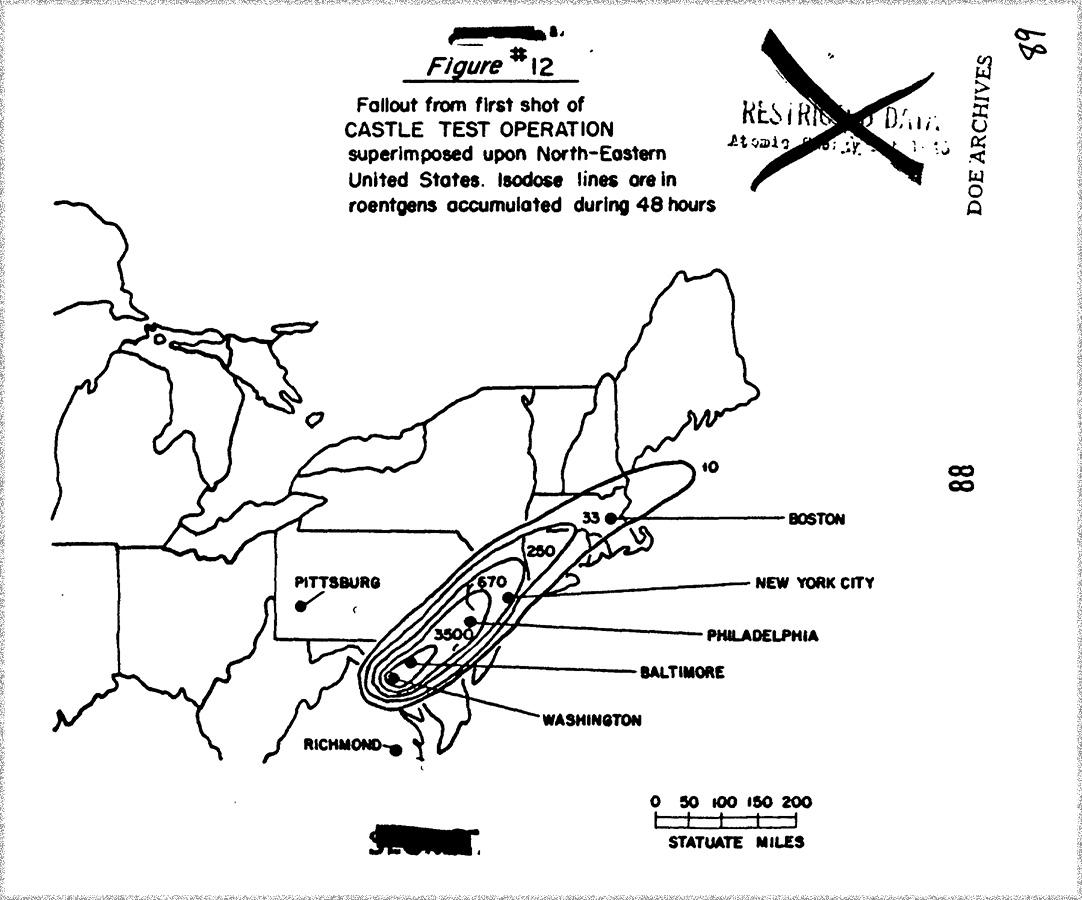
Chart from report on “Radiation Hazards During Atomic Warfare” showing fallout from Castle Bravo test “superimposed upon North-Eastern United States” (See Document 36)

The Japanese fishing boat Fukuryu Maru (Lucky Dragon) on display at the Tokyo Metropolitan Daigo Fukuryū Maru Exhibition Hall (Photo from Wikipedia)
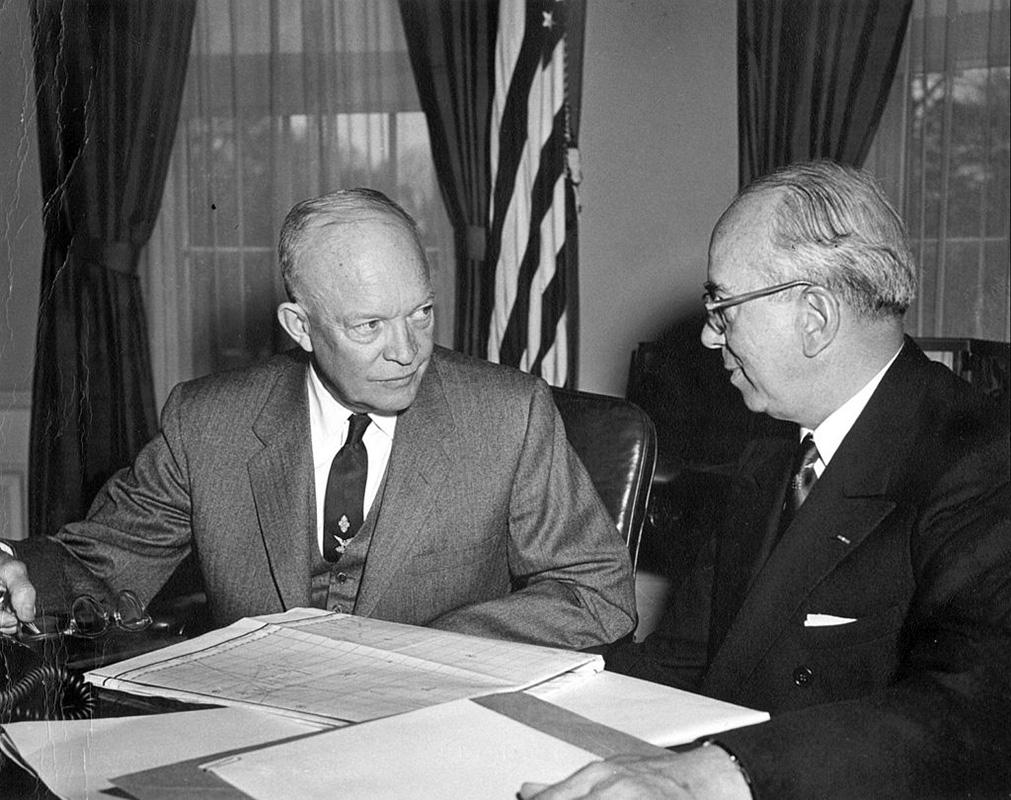
Atomic Energy Commission Chair Lewis Strauss briefed President Eisenhower on nuclear tests in the Pacific, 30 March 1954, the day before the press conference where Strauss denied that anything was “out of control” or “devastated” (Photo from Wikipedia)
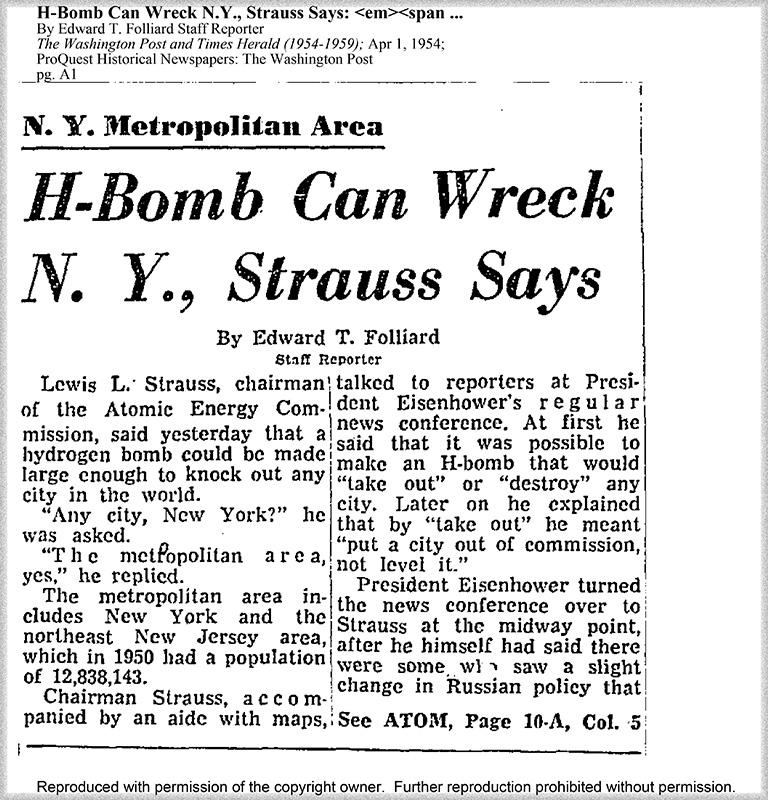
A newspaper headline the day after AEC Chair Lewis Strauss’s press conference where he said that an H-bomb could destroy the New York City metropolitan area (Washington Post, 1 April 1954) Listen to an audio clip of Strauss’s statement.
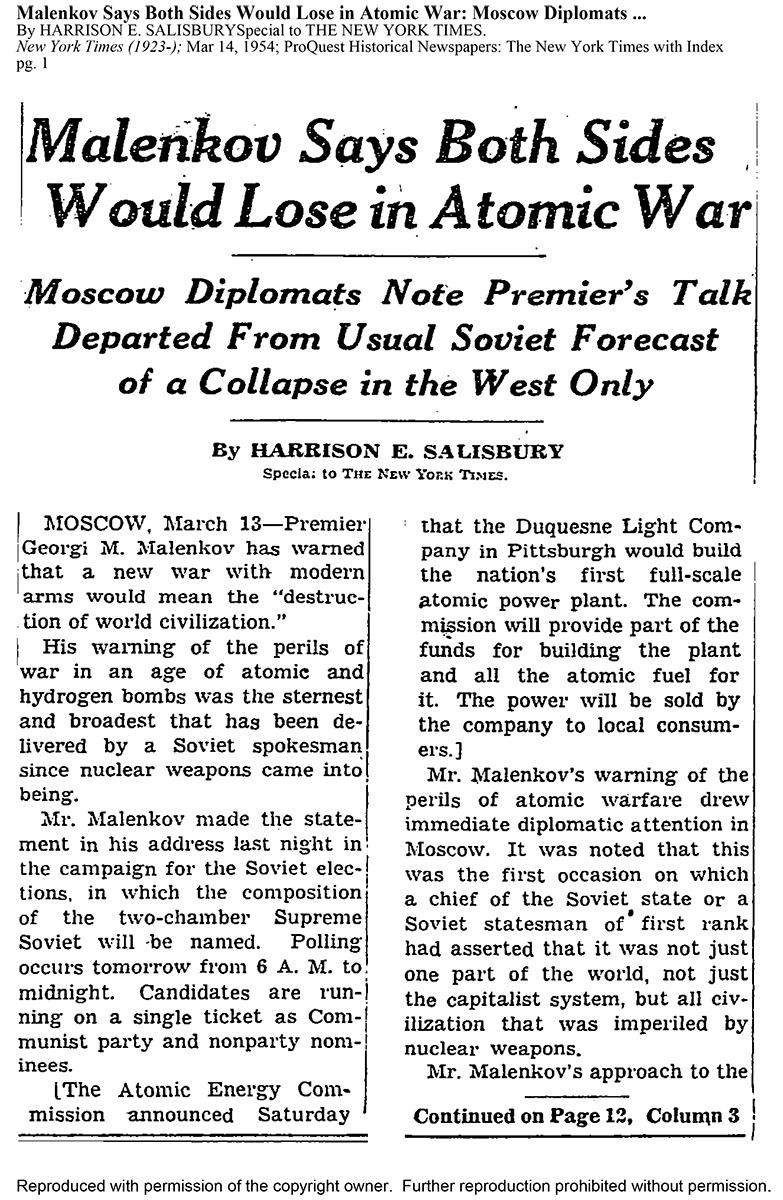
Responding to information about the Castle Bravo test, Georgi M. Malenkov, Chair of the Soviet Union’s Council of Ministers, declared that, if the world returned to Cold War confict, it could mean the “destruction of world civilization.” After Malenkov’s political rivals denounced his speech, he retracted it, but the message about the devastation of nuclear war would be a lasting one. (New York Times, 13 March 1954)
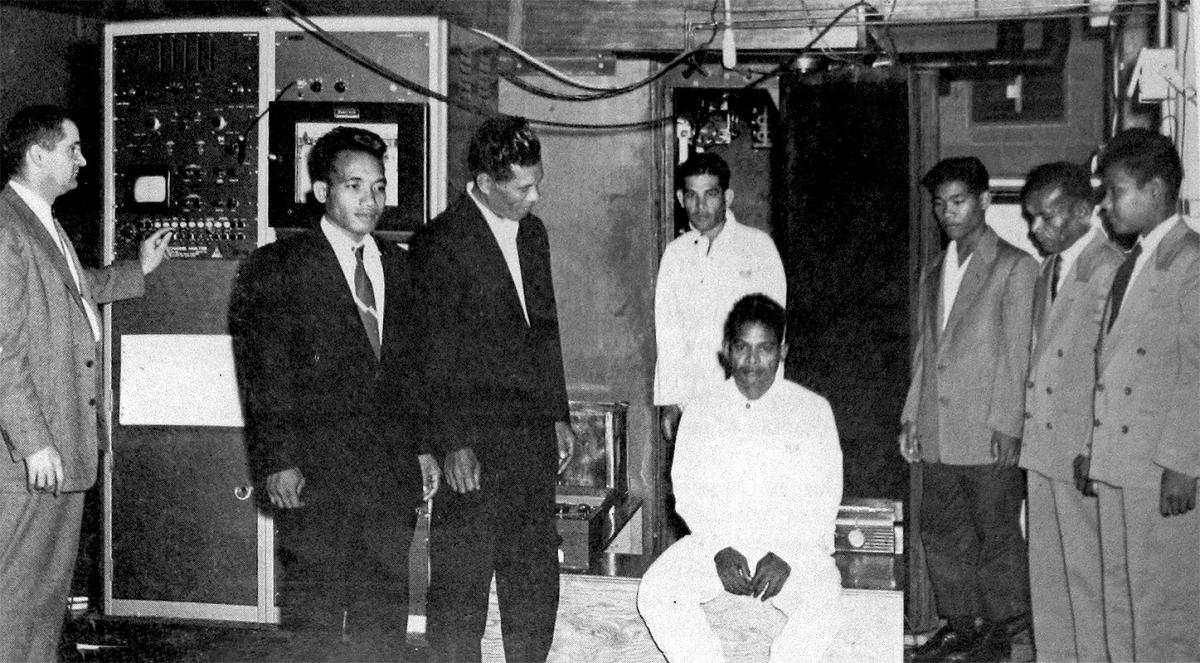
People from Rongelap Atoll at the AEC’s Argonne Laboratory, April 1957, for measurements of fallout fission products by a full-body counter (“iron room”). (L-R): Billiet Edmond, Leban, William Allen, Magistrate John Anjain (seated), Alex Lelen, Tima Marin, and Iroji Kebleni. (Image from Jack Adair Tobin Papers, Pacific Collections, University of Hawaii Manoa Library, box 2, Folder 158, Chicago Trek; courtesy of Professor Mary X. Mitchell, University of Toronto)
Washington, D.C., February 29, 2024 – Seventy years ago, on 1 March 1954 (28 February in Washington), the U.S. government air-dropped a thermonuclear weapon, code-named “Shrimp,” on Bikini Atoll in the Marshall Islands in what turned out to be the largest nuclear test in U.S. history. The Bravo detonation in the Castle test series had an explosive yield of 15 megatons—1,000 times that of the weapon that destroyed Hiroshima and nearly three times the six megatons that its planners estimated. The detonation vaporized some ten million tons of sand, coral and water that turned into a 100-mile-wide fallout cloud spewing radioactive debris on the inhabitants of Marshall Island atolls, U.S. military personnel, and Japanese fishermen aboard the Lucky Dragon.
To mark this calamitous event, the National Security Archive today features a selection of key documents on the Bravo test collected from three sources: the Department of Energy’s OpenNet database, Alex Wellerstein’s reconstruction of DOE’s vanished Marshall Islands Nuclear Document Database (MINDD), and from State Department records held at the U.S. National Archives and Records Administration (NARA).
Bravo’s fallout necessitated the evacuation of over 230 people from Rongelap, Rongerik, and Utirik atolls (all part of the U.S. trusteeship for the Marshall Islands), including 28 U.S. military personnel on Rongerik. The people of Rongelap had the greatest exposure to radioactive contamination. When the toxic cloud arrived at Rongelap, located about 110 miles from the test site, the fallout looked like snow; children played with the irradiated flakes while others kept working on outdoor tasks. The immediate health effects were serious and long-lasting, and Rongelap became uninhabitable.
In addition, 23 Japanese fishermen aboard the Lucky Dragon (Fukuryu Maru) were sickened by radiation exposure, and the subsequent death of one crewman helped bring international media attention to the dangers of nuclear fallout. U.S.-Japan relations were further roiled by a general sense of panic about potentially radioactive tuna, among other things, and the damage that such a perception could cause to Japanese exports. The health effects on the crew and the people of the Marshall Islands and concerns about the economic impact of the Bravo radiological disaster strongly influenced world opinion against nuclear testing, helping to spark at movement that ultimately led to the 1963 Limited Test Ban Treaty.
Included in this update of an Electronic Briefing Book published ten years ago, on the 60th anniversary of the Bravo test, are several films of the Bravo shot, including a U.S. Air Force film report from the commander of Joint Task Force 7, the unit that conducted the Castle test series. The film includes footage of both the Bravo detonation and the evacuation of U.S. personnel and Marshall Islanders in the wake of the test. The documentary is sanitized at points, apparently to protect nuclear weapons design information. A Freedom of Information Act (FOIA) request by the National Security Archive for a fresh review and a subsequent appeal failed to dislodge more footage from the classified film archives.
Other noteworthy documents in this posting include:
- Early reports of radioactive contamination on nearby atolls and on the decisions, days later, to evacuate Rongelap, Utirik and Rongerik.
- The secret directive establishing “Project 4.1,” the group charged with producing a “Study of Response of Human Beings Exposed to Significant Beta and Gamma Radiation Due to Fallout from High Yield Weapons.”
- Japanese government accounts of the Lucky Dragon (Fukuryu Maru) incident.
- The transcript and full audio of the 31 March 1954 press conference where AEC Chair Lewis Strauss stated than an H-bomb could “take out a city … destroy a city.”
- The May 1954 petition by Marshall Islanders for an end to nuclear tests in the area.
- U.S. Embassy Tokyo telegrams on Bravo’s adverse impact for U.S.-Japanese relations.
- Internal U.S. government deliberations over providing compensation to the Japanese government and to Marshall Islanders for losses incurred due to nuclear testing.
- Documents concerning the delay in returning inhabitants to Rongelap Atoll because of unsafe conditions.
- U.S. government studies from 1954 and 1955 on the radiation and fallout effects of Castle Bravo.
- The proceedings of an October 1967 conference sponsored by the Defense Atomic Support Agency on “selected effects of general war,” including reflections and assessments by individuals involved in the initial response to the Bravo crisis.
- A comprehensive Defense Threat Reduction Agency report from 2013 on Castle Bravo exposing “legends and lore” about the test.
How and why Bravo produced a far greater explosive yield than estimated is a puzzle that has been substantially solved, even if little of the evidence has been declassified. Apparently, the designers at Los Alamos National Laboratory understood that the explosive yield could be far greater than the estimated six megatons, possibly as high as 15. Taking that into account, they advised the Joint Task Force to take measures to protect the safety of service personnel. [See Document 44] To increase the explosive yield, the weapons designers included lithium deuteride in the fuel for Bravo, some of which was in the form of lithium-7. But the lithium-7 was not inert, as the designers had assumed. Instead, when ignited, it produced tritium, a fusion fuel, and this greatly increased the explosive yield of the “Shrimp” test. As Los Alamos weapons designer Carson Mark explained in July 1954, the problem was that lithium-7 “had been assumed to be a much less good fuel than lithium-6.”[1] [See Document 35]
Before the Castle Bravo detonation, the possibility that fallout could reach the inhabitants of atolls a hundred miles away (and the U.S. personnel stationed there) was not seriously considered. Unlike 1946, when the people of Rongelap and other atolls were temporarily evacuated during the Bikini tests, the U.S. military made no arrangements to evacuate nearby people during Castle Bravo. And because the first U.S. H-bomb test, the November 1952 ten-megaton Ivy Mike detonation, produced little detectable fallout (with most of it falling either into the ocean or lofting into the stratosphere), the planners unrealistically assumed there was little to worry about. Moreover, tight budgets reinforced decisions against precautionary evacuations. [See Document 44][2] Nevertheless, Bravo, detonated on an islet in a coral reef, produced massive levels of fallout that quickly reached the stratosphere before falling back to earth.[3]
According to the recollections of Merril Eisenbud, who was the director of the U.S. Atomic Energy Commission’s (AEC) Health and Safety Laboratory in New York, “there was a very, very influential group of people, both among the military and civilians, who insisted that there never was any … fallout” from the Ivy Mike test. Thus, when the AEC “recommended an evacuation capability … this was denied [by the military] on the basis that it wasn’t necessary; that there would not be any fallout.” [See Document 43] Speaking to such failings, Wellerstein wrote that Castle Bravo is a “cautionary tale about hubris and incompetence in the nuclear age,” where scientists and military officials detonated “a weapon whose size they did not know, whose effects they did not correctly forecast, whose legacy will not soon be outlived.”[4]
The architects of the Castle test series shrouded it in secrecy. Seeking to keep words like “hydrogen” and “thermonuclear” out of the public discourse, the Eisenhower administration only announced the fact that atomic tests would be held in the Pacific during 1954. After the Bravo shot occurred, the AEC and the Defense Department sought to control what was known about it, especially the high levels of radioactive contamination. But on 11 March, a letter from a U.S. Marine stationed at Kwajalein describing the detonation and the evacuations was quoted in a Columbus, Ohio, newspaper. Days later, the sickened Fukuryu Maru crew returned to port, and the fallout problem could no longer be concealed.[5]
The rapidly spreading news of the Bravo shot’s fallout gave Washington a serious damage control problem. At a press conference at the end of March 1954, AEC Chair Lewis Strauss made misleading statements about Castle Bravo and others that were simply false, such as his claim that the Fukuryu Maru was “well within the danger area” established by the U.S. Navy around the test site, primarily to exclude observers. Strauss produced newspaper headlines when he said that hydrogen bombs could “take out a city, any city,” including one the size of New York’s metropolitan area.[6] [See Documents 16 and 16A].
Audio file
Listen to an audio excerpt of Strauss’s statement (Source: Dwight D. Eisenhower Presidential Library Audio-Visual Collections)
The long-term consequences of the Bravo test, especially its disruptive impact for the people of the Marshall Islands, the adverse health impacts, and the settlement of financial compensation claims, are beyond the scope of this collection. One document in today’s posting, the transcript of an October 1967 interdisciplinary conference on the effects of “general war,” included retrospective reflections and assessments by scientists and doctors who were involved in the initial response to the crises created by Bravo. [See Document 43] One participant, Dr. Robert Conard, who directed radiation studies on Marshall Islanders, highlighted “the most serious finding in the Marshallese … the development of the thyroid abnormalities,” a result that he subsequently described as a late result of fallout exposure. The wide-ranging discussion during this meeting reflected on this and related problems, including nuclear physicist Theodore “Ted” Taylor’s observation that “obviously we didn’t irradiate the natives on purpose. Obviously, we didn’t know what the hell we were doing … We deny the fact that we didn’t know what we were doing, but there is no basis for confidence anymore.”[7]
During that same conference, Merril Eisenbud made a point about the military implications of Castle Bravo-type nuclear weapons: “anyone could take that diagram and lay it on a map of Europe, let’s say, by putting Bikini near some important Soviet airbase, and point the wind anywhere you choose to, and get 800 [roentgen[8]] per hour running through friendly nations. This is why I say we have bombs which we are probably no longer in a position to use; imagine the impact of this possibility militarily.”
The fallout studies included in this posting underlined the importance of Eisenbud’s point. For example, an Air Research and Development Command report included tables superimposing the fallout produced by Castle Bravo during the first 48 hours after detonation on a map of the northeastern United States. The tables showed that there was no place to hide.” According to the report, “an unprepared and an uninformed nation will suffer horrible casualties from radiation.” [See Document 36]
Whether multi-megaton weapons were usable or not, they would be deployed as the MK-17 thermonuclear bomb. For U.S. military planners the possibility of massive devastation was a spur to build and field more powerful, high-yield weapons. The Strategic Air Command’s leader, General Thomas Power, would seek a 60-megaton bomb, and after the Soviets tested their 50-megaton “Tzar Bomba” in October 1961, Kennedy administration officials reviewed the possibility of developing weapons with far greater yields. Yet nothing was produced that exceeded the 23-megaton Mk-41, which was deployed during the 1960s, the most powerful weapon in U.S. nuclear history.[9]
Sources on Castle Bravo
Much on the Castle Bravo test and its impacts has been released, but important sources remain classified, such as the text of General Kenneth Field’s briefing to the Atomic Energy Commission in May 1954. [See Document 32] Similarly, briefings to, and discussion by, the Atomic Energy Commission’s General Advisory Committee (GAC) have been available only in heavily excised form for years [See Documents 30 and 35] and need further declassification review, although the Restricted Data in such sources will likely keep much of the text classified. Documents on the State Department’s early reactions to, and understanding of, Castle Bravo also remain classified at the National Archives, although much on the Lucky Dragon and related issues is available.
Digital databases holding many declassified records on nuclear testing in the Marshall Islands and its impacts remain important sources but have a checkered history. During the 1990s, documents concerning human radiation experiments and research, including nuclear tests in the Pacific, were available on the HREX database maintained by the Department of Energy (DOE), but the Department shut down HREX in 2001 for budgetary and technical reasons.[10] Many HREX records were eventually incorporated into the DOE’s online collection of more than 13,000 documents: “The Marshall Islands Document Collection.” Due to budgetary considerations, that important collection (along with several other DOE collections) disappeared from the Web at the time of the 2013 government shutdown. Since then, Wellerstein, with the Stevens Institute of Technology, has spearheaded the reconstruction of the disappeared Marshall Islands database, including most of the PDFs. Many of the documents from the old DOE Marshall Islands collection and related material can also be found on DOE’s OpenNet.
Another important and unique collection on the consequences of nuclear testing in the Marshall Island from outside the U.S. government consists of the case files of the Marshall Islands Nuclear Claims Tribunal, which closed its doors in 2010. The collection of paper records constitute an irreplaceable and invaluable record of the impacts of nuclear testing on a vulnerable population but are stored in the former offices of the Tribunal in Majuro where, like so much else in the islands, they are vulnerable to the effects of climate change. To assure their long-term availability, an international collaboration of archivists and researchers digitized both the textual and audio-visual records and have made them available at the City Archives of Girona, Spain (the audiovisual records) and the Swiss Federal Archives (the paper records and photos).[11]
Note: Thanks to Howie Southard, George Washington University Academic Technologies, for converting the Air Force film into digital format; Trudy Huskamp Peterson, for valuable information on Marshall Island sources; and Alex Wellerstein, Stevens Institute of Technology, for sharing his knowledge and his collection of photos and films of the Bravo test.
THE DOCUMENTS
Source information: Unless otherwise noted, the documents in this collection are from three major sources: the Department of Energy’s OpenNet collection, the reconstituted Marshall Islands Nuclear Document Database (MINDD) and the State Department central decimal files covering 1950-54 at the U.S. National Archives. The State Department records on the Lucky Dragon incident are from two decimal files in particular: 711.5611 and 211.9441 (which are indicated on each document). Other important documents can be found in U.S. Department of State, Foreign Relations of the United States, 1952-1954,Volume XIV Part 2: Japan (Washington D.C.: Government Printing Office, 1985).
